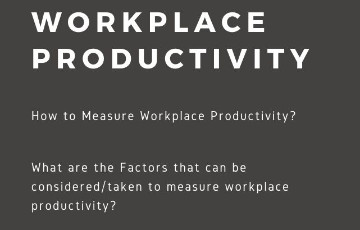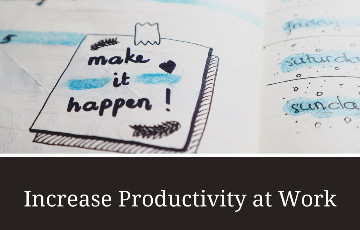
1. Daily Check-In Strategy:
The strategy involves Monitoring daily updates on what’s going on with the team, employees, targets, and tasks.
2. Measuring Team Productivity:
Monitor weekly/monthly reports, quarterly reports of the teams.
Prepare statistics based on:
1. How good is your team functioning?
2. How happy are the teams?
3. Is everyone in the team contributing equally?
4. Or a single person carrying entire team?
5. What troubles they have as a team? Etc.
Do Reviews Based on:
Team’s Task-completion
Time-Management.
Overall performance.
Team’s leadership.
Monitoring Team-productivity is vital for measuring workplace productivity.
3. Measuring Individual productivity:
Assess factors like employee total working-hours, how many hours were productive out of total working-hours, employee skill set, etc. As a company, consider the non-essential tasks, irrelevant routines/meetings, and other distractions that employee experience in the workplace.
4. Benchmark Strategy:
Set benchmarks. Or, you can take previous benchmarks, Industry benchmarks, and market benchmarks. We can also set the Benchmarks to teams, individuals targets to measure productivity levels.
5. 360° Feedback/Peer Assessment Strategy:
Establish peer assessment criteria formally. It helps in avoiding personal judgments, grudges, or emotions to overtake while assessing a fellow employee.
6. Measuring Output:
Output can be in terms of sales, team/individual performance, target-achievements, reaching-goals, etc.
Analyzing quality over quantity is important. Also, consider both quality and quantity depending upon situations.
Decoding the output-levels will support you in measuring workplace productivity.
7. Finances:
Analyze the total revenue generated, profits and loss, money spent on employee’s betterment.
Consider overall financial goals. For example, you may have key financial goals for the month, or year, or for others.
Financial analysis is important to measure workplace productivity.
8. Task-Completion Rates:
It is difficult to determine how much time it takes or how much time is right for completing tasks exactly. It will involve various factors.

Based on five different scales, we can easily understand what a productive workplace looks like.
On a Health Perspective:
1. The workplace should promote and support employee wellbeing and health.
2. A workplace should provide a Safe and Secure Environment.
3. Workplace design should enable employee moments instead of sitting in the same place for hours.
4. Have optimum conditions to bring comfort to workers.
5. Have a clean and tidy environment.
6. Have Access to healthy food and good hydration.
7. Have Safety medical equipment, quick first-aids, and other emergency medical facilities.
Workplace Efficiency:
1. The workplace should enable employees to do their jobs without unnecessary disturbances.
2. Employees should be able to make use of the office environment for their productivity.
3. A workplace should train and make their employee's competent.
4. Enable good use of office spaces, timings, and other workplace resources.
Effectiveness of a Working environment:
1. Good team dynamics
2. Motivated employees.
3. Good leadership.
4. Good management.
5. Ease and flexible working.
These 5 factors determine workplace effectiveness.
Engaged Workplace:
1. The engaging office environment is important for productivity
2. We should make communications from all levels easy and more interactive.
3. Employees should feel engaged.
4. Employees should feel valued, appreciated, and respected.
Giving Back To The employees:
1. A workplace should not always concentrate on harvesting employee efforts/results.
2. The workplace should give back in terms of knowledge, opportunities, and possibilities for employee career growth.
3. We should give employees financial allowances, perks, and benefits.
4. Giving a platform for employees to enhance their skills and talents.
5. A workplace should give different exposures to employees.
In short, we can summarize workplace productivity as:
Good Workspace.
Up-to-Date operative work environment.
Exposure to knowledge and opportunities.
Competent Human Resources.
Overall Positive work environment.
Flexible and Comfortable Work practices.
Based on all these criteria, workplace productivity can be measured to a good extent.

1. Make Employees Feel Safe and Good:
Employees spend most of their time in the workplace. Make them feel like a family.
2. Don’t kill Employee Morales:
Don’t curtail their basic needs, break times, resources, and sorts in the name of bringing discipline and order. Killing employee morale in any way decreases workplace productivity.
3. No Favoritism in the Workplace:
It is an essential quality to be followed in the workplace to boost employee performance.
4. Celebrate little achievements too:
Appreciating little achievements and celebrating it gives a morale boost to employees. It helps them to stay productive in the workplace.
5. Give Clear Goals:
Don’t burden your workforce with unrealistic goals and deadlines.
6. Gamification Tactics:
It involves giving rewards, badges, ranking-points, challenges, etc. It makes employees stay enthusiastic and productive in the workplace.
Keep it positive and fun. Else, these tactics can become counterproductive.
7. Good Leadership:
Good leadership brings people together. It motivates people to become productive.
8. Reduce Stress:
Stress is unavoidable. But still, try providing a stress-free environment as much as you can to your employees.
9. Good workstations:
Provide comfortable, spacious, and convenient workstations to function and work in a relaxed manner.
10. Don’t Hover:
Employees don’t appreciate their managers/superiors to hover around them all the time. Give them their space. Your employees are adults who don’t need constant supervision like children.
Employees don’t welcome 'Helicopter Bosses'.
11. No Micromanaging:
Give freedom to your employees to express their working style. Don’t dictate work. Allow your employees to bring creativity. Give them the freedom to express themselves. It’s an important strategy to enhance workplace productivity.
12. Listen:
Hear your employees' concerns. Understand their problems.
13. Keep them engaged and Stay Active:
It’s important for workplace productivity.


